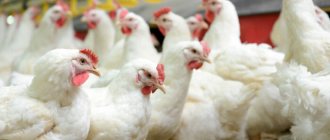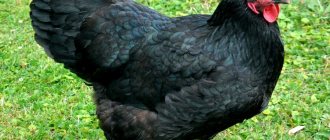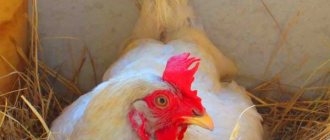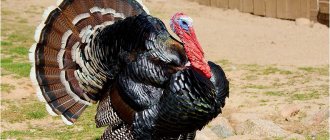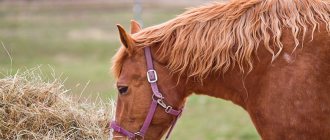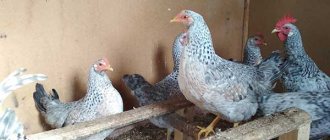When planning to start a business selling large quantities of chicken meat, you need to calculate in advance how much a chicken of a particular breed or variety weighs. This will help determine the number of chickens, feed and the approximate timing of receiving goods for sale. In the article you will find information about the weight of broilers and laying hens. You will learn how and when to weigh birds while raising them.
Why do you need to control your weight?
The body weight of chickens must be constantly monitored. This will avoid unnecessary expenses on the purchase of feed and additives. Why overfeed a bird that has already reached its weight limit.
It will be possible to stop adding nutritious feed in a timely manner. Before chickens develop obesity.
By monitoring your weight, you will be able to identify those from the herd who are not receiving enough nutritional supplements. After all, underfed chickens develop rickets, gout and other diseases.
By controlling the growth of chickens, you can simultaneously monitor their health. Sick birds refuse to eat and quickly lose weight. Knowing how much a broiler or purebred chicken should weigh at a certain age, you can promptly identify those who are sick.
How to correctly determine mass
To find out how much a broiler or purebred chicken weighs, use electronic scales, a steelyard, a regular bag or a cardboard box. Start by determining the tare weight. It will need to be subtracted from the total indicator on the scales.
A small chick can be weighed in a gauze bag with a tight bottom and handles. To weigh adult broilers, bags and burlap sacks are used.
To prevent the bird from twitching and creating disturbances, two holes are made in the bottom of the bag. The chicken's legs are inserted into them and fixed in a standing position, holding it by the body through the bag.
If the bird is restless and it is not possible to weigh it in a bag, use a cardboard box. Calmly behaved chickens are simply placed on scales and weighed.
What does weight depend on?
Variety: Given the same amount of feed, broilers weigh more than purebred chickens. This is due to the genetic characteristics of their body.
Productive focus: chickens are raised for eggs and meat. Representatives of any breed can cope with this task.
But the quality of the resulting product and its quantity also depend on the productive orientation or propensity of the chicken to produce and accumulate the product. Thus, the average weight of broilers is 3-4 kg, and egg-laying chickens are 1-2 kg.
Nutritional value of feed: if a bird does not receive all the nutrients necessary for its growth, then its weight will be less.
The weight of a chicken also depends on its age. So, day-old chicks weigh very little. But with proper care and feeding, they grow quickly and gain size.
Keeping chickens
It’s easy to create conditions for chickens. They only need a small clearing for grazing and a simple shed for spending the night and wintering. It is important that both the pen and the building are kept dry, otherwise the hens may become ill. Also note that many animals, such as wild dogs and ferrets, prey on birds. When installing pen fencing, holes and cracks must be carefully sealed.
Nutrition
Chickens are omnivores, eating vegetables, grains, baked goods, seeds, grass, insects and worms. In spring and summer, you can practically not worry about their nutrition, provided that they have a paddock in which a lot of grass grows. If there is no vegetation, then there are two ways out of this situation:
- Mow the grass with a lawn mower and spread it around the pen or pile it in one pile, then the hens themselves will rummage through it, looking for insects and worms.
- Herd chickens on the property. In this case, the shepherd is completely unnecessary. Poultry roam the area, feeding on plants, insects and worms. However, flower beds or a vegetable garden may suffer if the laying hens are not promptly driven to the territory allocated for them.
Depending on your budget, goals and circumstances, there are several ways to organize feeding of laying hens in winter:
- Grain is the most budget option. It is enough to buy 2-3 bags, but it is worth considering the disadvantages of such a diet. If the purchased pullets were accustomed to mixed feed, then they will not peck regular grain. Also, the grain mixture must be mixed with vitamins. If birds are not given vitamins in full, their maintenance will become unprofitable.
- Compound feed is the most expensive food. When using specialized feed, you do not need to worry about vitamins, since egg production will always be at an excellent level.
- Steamed cereals and wheat products. If you have old grains or pasta that can no longer be cooked, they are perfect for feeding birds. In the evening they need to be soaked in a large container, and in the morning they can be given to the chickens. Many poultry farmers add leftover vegetables and food to this mixture. This way the food is rich in vitamins.
It is also worth taking care of water. Chickens drink a lot, because their diet mainly includes dry food and specialized feed.
Causes of failure to gain weight
Quality of feed and quantity of feeding: in winter, birds are fed three times a day. In summer, the number of feedings is reduced to 2 times. The low calorie content in feed has a significant impact on the weight of a broiler or purebred chicken. Food should be supplied to the feeders on schedule.
Improper growing conditions: Birds should not be kept in cramped, poorly ventilated areas with insufficient light. A large walking area also has a negative impact on weight gain.
Molting: Chickens may lose some weight during this time. Usually the change of plumage occurs in the fall. Therefore, there is no need to delay slaughter.
Diseases: Sick chickens lose weight quickly. Sometimes it is easier to slaughter a bird immediately after the disease is detected. This allows you to retain some of its productive value.
The reason for the insufficient rate of weight gain may be the characteristics of the species. Broilers gain weight faster than other chickens.
Why don't chickens grow?
Sometimes a chicken seems healthy and you try to feed it properly, but it doesn't grow. There may be several reasons for this:
- Temperature conditions. In the first days of a chicken’s life, a temperature of at least +30 degrees is required. Only after two weeks it can be reduced to +25 degrees.
- Few vitamins. Regardless of the amount of food given, chicks may lack vitamins and minerals in their diet. If there is not enough calcium in the diet, it will greatly affect growth and weight gain.
- Lack of consistency in meals. Chickens, often broilers, do not always gain weight, even if the food is rich and nutritious. This is explained by the fact that there is no consistency and no specific schedule. Animals must receive food every few hours. This time should be the same every day.
- Parasites. If parasites appear in the body, they greatly slow down the development of the chicks.
Problem solving and prevention
Rapid weight loss can be prevented.
There is a difference between winter and summer bird rearing. If you follow the rules, the chickens will gain weight as needed.
In winter, chickens are given grain, wet potato mash, grated beets, bran, chopped hay and silage, and grain waste. In the summer the chickens are released to graze. And they try to introduce more fresh vegetables and herbs into the daily diet. Chickens are fed 2-3 times more often.
Birds must have constant access to fresh water.
Daylight hours during molting should last up to 8 hours. After changing the pen, the daylight hours are increased to 13-14 hours.
Winter air temperatures should not fall below 5 degrees.
Sick chickens are separated from healthy ones and quarantined. The room is treated with lime and ventilated.
Accommodation rate: 3-5 individuals per 1 sq. m.
How many kcal are in a chicken drumstick?
There are 118 calories in 1 leg of Chicken Drumsticks with Skin, boneless.
Interesting materials:
How to properly freeze Chinese cabbage? How to exercise on a stepper correctly? How to steam buckwheat correctly? How to correctly fill out a property deduction declaration? How to correctly fill out p14001 when adding OKVED? How to correctly request a reconciliation report from a supplier? How to properly charge the Robot vacuum cleaner? How to properly sow lawn grass with your own hands? How to properly brew buckwheat overnight? How to properly certify a copy of a work book 2022?
All about broiler weight
Dial speed and weighing nuances
The weight of broilers differs from the weight of purebred chickens at the same age. In the first 20 days of life, their weight increases 20 times.
A newly hatched broiler chicken has a body weight of 40 to 44 g. It is well built. Thanks to its powerful legs and thighs, the broiler looks stronger than chickens of other breeds.
1 day after hatching, another 10-15 daily weight gain will be added to 40-44 g. For more information about the rate of weight gain, read the article “How long does a broiler grow for meat.”
The weight of the bird is determined by weighing. The procedure is carried out daily or once every 10 days. At the same time of day, preferably before feeding. Extreme accuracy allows us to determine the effectiveness of additives introduced into the chicken diet.
It takes no more than 3 months to fatten broilers. After slaughtering 1 bird, it is possible to obtain from 2.5 to 3 or more kg of meat.
Broiler weight by day
The broiler growth chart will help you achieve positive results with less losses:
The table of broiler weights by day gives standard norms. Deviations of 50-60 g are acceptable.
We equalize the indicators and determine the average parameters
In order for the weight of the broiler stock to be approximately the same, the birds must be kept in the same conditions.
The optimal air temperature in the room where day-old chicks are kept is 30 degrees. When they reach 2 weeks – 25 degrees. At 1 month, the air temperature can be lowered to 20-18 degrees.
With intensive fattening of broilers, it is even possible to place 5-10 individuals in cages.
If there are a lot of chickens, then to determine the average weight, 10 individuals are selected from every hundred and weighed.
In this case, an error of 10% must be taken into account. It occurs due to the presence of both cockerels and hens in the livestock. Females weigh less than males by about 500 g. Their rate of weight gain is also slower.
Are extra pounds good?
If a broiler weighs more than normal at the time of slaughter, this is not very good. Because such indicators indicate obesity. Causes of excess weight:
- the presence of saturated fatty acids in feed;
- painful condition;
- consumption of feed in excess of the prescribed amount.
The presence of fat in the carcass reduces its consumer value. When cutting, the fat mass will have to be thrown away or processed.
Fatty meat contains large amounts of cholesterol, which is harmful to human health.
Information from the article “Feeding standards for broilers” will help you avoid problems.
Laying hen weight
General characteristics
The main purpose of raising laying hens is to produce a large number of eggs.
Good growth of broilers is achieved due to the high degree of digestibility of feed. Laying hens are more capricious in this regard.
Even when consuming the same feed as meat birds, laying hens rarely reach the same body weight. The reason is genetics.
Naturally, egg-laying chickens can also be slaughtered for meat. But it is more advisable to use them for their intended purpose.
Dial speed and weighing nuances
A laying hen chick that has just hatched from an egg weighs on average 25-35 g. During the day it gains 5-6 g. After 10 days, the weight of the chicken is 60-90 g.
A sexually mature laying hen weighs from 2.5 to 3 kg. It reaches this mass in 5-6 months.
Laying chickens are weighed on average once every 10 days.
In small farms, the weight of the chicken is determined immediately before slaughter. But on poultry farms, laying hens are weighed to determine the reason for the lack of the required number of eggs.
This information helps to understand whether the bird is receiving the required amount of nutrients. Find out what effect a changed nutritional diet has on her. And also, is the chicken sick?
Weight gain
Whether the hen is gaining weight correctly is determined based on the table:
As can be seen from the table, the weight of a rooster is greater than that of a chicken. The thing is that males increase in size faster than females.
Reasons for slowing down weight gain
The first eggs can be obtained from laying hens when they reach 4.5-5 months. Before egg work begins, they may stop gaining weight.
This is normal. But you shouldn’t feed the chicken less. During egg laying, laying hens require special nutrition. What is described in the article “What should you feed laying hens so that they lay a lot.”
Chicken breeds
There are many varieties of poultry for meat on the market. More often, farmers choose broilers, as this is the most successful variety of birds when keeping them for meat production. However, there are other breeds that can produce meat and egg products. Let's look at several types in more detail.
Table No. 1. Meat breeds of chickens
| Name, photo of the breed | Description of the breed |
| This common bird species is native to Asia. They are characterized by large strong wings, long legs and a large body, with a large percentage of meat. The comb of these chickens is small, but fleshy. Representatives of this breed, despite their meat orientation, lay a lot of eggs. Each year, each hen produces at least one hundred eggs, the size of which reaches 63 grams. Brahma can have different plumage color options. For example, they come with white feathers tipped with silver hues arranged like ovals. In most males, the upper part of the body has these plumage colors, and the lower part has a black-green tint. A female Brahma can gain weight up to 3.5 kilograms, while in a rooster this figure sometimes increases to 4.5 kilograms. Bird meat is somewhat tough. However, it is considered dietary, and also very nutritious. | |
| This is the largest chicken of all available breeds, which was bred by US breeders in the 20th century. The color of the plumage can be of three shades: white, black, blue. The body size is large, thanks to which they can be kept behind small fences, since chickens will not be able to overcome them due to their size. Giants also love spacious areas for walking, but if such opportunities are not available, they will grow well in limited space. The appearance of chickens is quite simple: a large body, strong paws, and a short tail typical of most meat breeds. This type is not suitable for eggs. Due to their large size and clumsiness, hens can crush eggs under them or throw them out of the nest. Therefore, if you use giants to obtain eggs, it is better to place the products under other laying hens or use an artificial incubator. In terms of weight, females gain up to 4.5 kilograms, and males are able to grow up to 6.5-7 kilograms, which is very unusual for chickens. | |
| Representatives of this breed are called the most meat chickens among the breed. They have a large body, head, and wings that fit tightly to the body. Externally, there is one special feature that helps to accurately determine the sex of birds: in males the comb is located vertically, and in females it hangs down to the sides. The color of the plumage can be very diverse: from black and white to blue, turning into red. It is important in breeding these birds to constantly monitor their weight, since they need a balanced diet, including all trace elements and vitamins. This greatly affects the volumes as well as the quality of the finished product. These chickens are very picky, especially in terms of temperature. A sudden change in climate or weather conditions can have a bad effect on their condition. They are also susceptible to encephalitis, and therefore they need to be vaccinated on time. | |
| Cochins are originally from China and are now used more as ornamental plants. There are two types of birds: common and dwarf. The differences are only in the size of the birds. Cochin is a distant ancestor of Brahma, since this variety is very ancient. Their appearance is represented by a bright red crest resembling a crown, yellow, blue or orange plumage. Chickens are physically inactive due to their build. They are quite apathetic and sit peacefully on their perches most of the time. Hens grow up to 4.5-5 kg, roosters – up to 5-5.5 kg. The former lay about 100 eggs per year of medium size. Despite their pickiness, they need a proper diet. | |
| The birthplace of this breed is in England. She was brought out at a time when residents were in great need of food, and especially meat. Therefore, they created it as a meat animal in such a way that it could gain good weight with inadequate and infrequent nutrition. Bird feathers are mostly white. Externally, they are the same as the Giants - large body, short tail. The height of birds is smaller than other meat breeds. Initially, representatives of this breed were frail, sick chicks. They gave eggs small and very rarely. Now they have been improved so much that it is often used as a basis for creating and improving other breeds. Laying hens can produce eggs up to three years of age, producing 180 eggs per year. | |
| Raspberries come from Belgium. They are physically sloppy, clumsy, and heavy. External characteristics differ little from the previous breed. Plumage can be varied. But often this is striped plumage of black, white, and sometimes blue, red and pearl colors. Laying hens have poor maternal instinct. Also, all chickens of this breed are highly dependent on food, but otherwise they are unpretentious. In addition, Malin’s chicken survival rate is more than 80 percent. When kept at home, these animals require some space for walking. However, they cannot fly, and therefore a large fence is also not required. The size of the birds ranges from four to five kilograms. Laying hens are capable of laying eggs throughout the year. During this time they produce about 150-170 eggs. | |
| This chicken was bred in the 19th century in the USA. The name includes the name of the city of Plymouth in which they originated, and the particle “rock”, which symbolizes the strength, endurance and large size of the chickens. Also, their meat has good taste, and the animals themselves are able to gain a lot of weight in a short period of time. The plumage of birds can vary, but it is believed that white hens and roosters are the most productive and viable. They are the ones that have the largest volumes compared to the rest of their brothers. The development of chickens occurs very quickly - after just six months, the young begin to lay eggs. They are unpretentious and resistant to any conditions. |
Let's sum it up
Controlling the weight of chickens raised for meat or eggs is essential. Timely information about changes in poultry weight allows you to avoid production losses. And also prevent the development of serious diseases.
It is also useful to control egg mass. Find out why in the article “How much do chicken eggs weigh by category.”
If you are interested in the article, please rate it 5 stars.
Leave comments - your opinion is important to us. By sharing an article with friends on social networks, you will find interlocutors.
